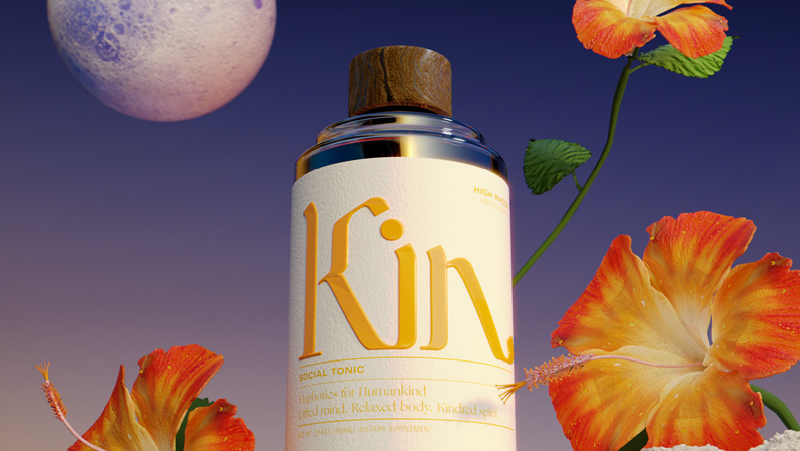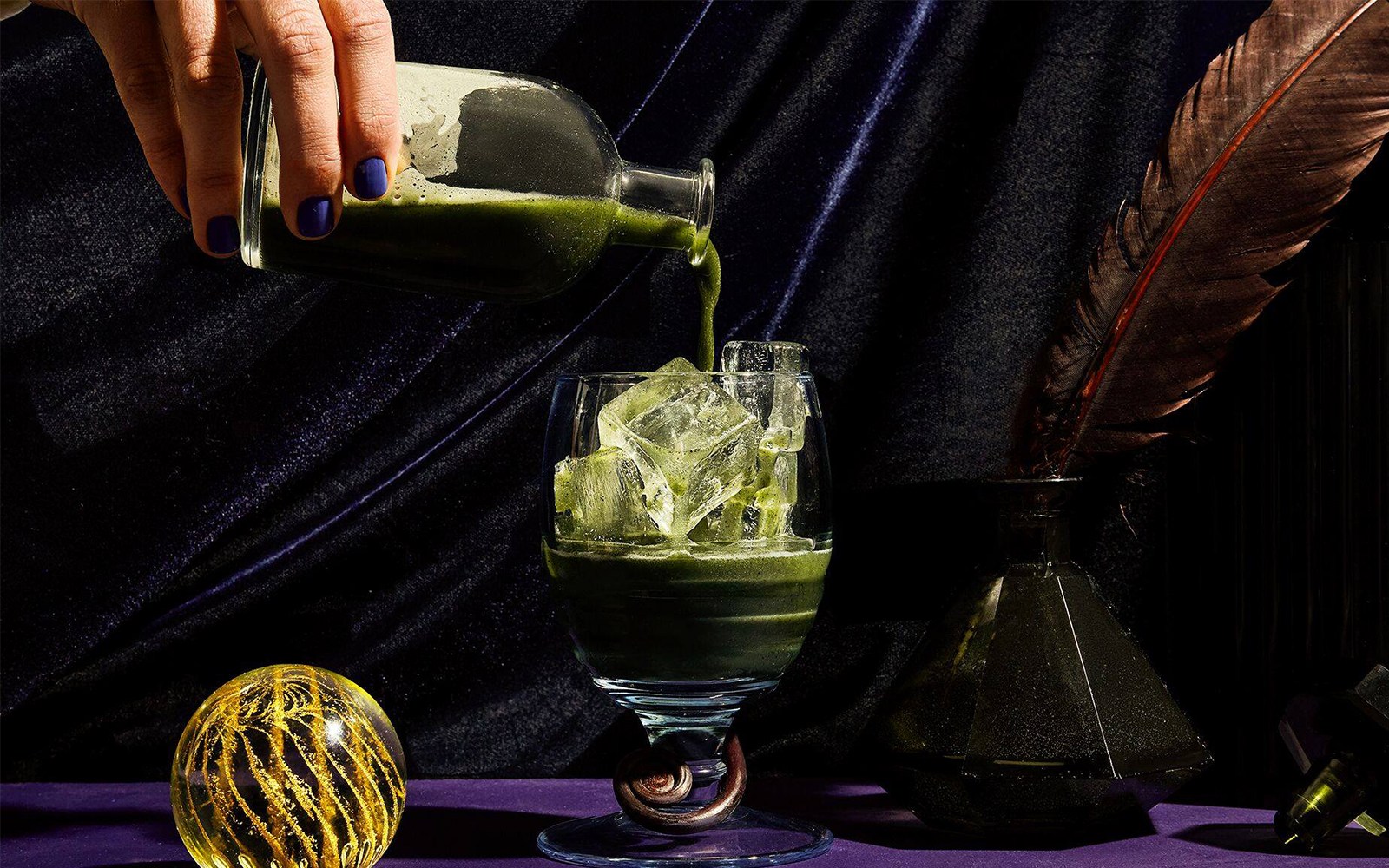Behind The Brand: Kin Euphorics
It’s not uncommon to see new companies offering a better alternative to a traditional product or an innovative approach to a common problem. But when a company invents a category from scratch, it’s worth a closer look.
Kin Euphorics is an upstart brand growing in popularity due to its modern branding, intriguing mission and, perhaps most of all, its totally mystifying product. Let’s dive in.

Product
When it comes to Kin, the conversation starts at the product. Why? Because, we’re pretty sure you’ve never seen anything like it.
Kin creates euphorics, an invented category of adult beverages. According to Kin, euphorics are “created from a stack of balancing adaptogens [herbs that help manage stress], replenishing nootropics [compounds that support cognition], and nourishing botanics”.
The drinks are alcohol-free but promise an otherworldly experience all the same. The combination of adaptogens, nootropics, and botanics are meant to be both relaxing and uplifting.
While the brand hinges heavily on the experience of euphorics, Kin is quick to state that there’s no one result you can expect from the product — noting for some people, the effect is “a mind-melting calm” while for others it’s an “uplifting joy”. And the most impactful variable, as it turns out, is you — “which has just as much influence on the effect of euphorics as what’s inside the bottle.”
Translation: Kin offers a drinkable cognitive supplement that you may or may not feel an effect from.
There are two products to choose from: the Kin Spritz and the Kin High Rhode.
- Spritz ($27): A four-pack of 8oz. cans that feature a sparkling euphoric pre-mixed with fresh citrus, hibiscus, and ginger.
- High Rhode ($39): A 500ml., eight-serving bottle that features an herbaceous euphoric that is meant to be mixed (and shared).
When reading the product descriptions, the difference between the products is unclear aside from the sparkling nature of the Spritz. And in looking at the ingredients listed on the site, there’s not much of a difference at all. They share the exact same ingredients.

Positioning
Kin leans heavily into the line “All bliss, no booze.” The short and pithy copy reveals quite a lot about how this product is being positioned in the market: an alternative to alcohol.
There is a growing audience of young adults that want to go out and have fun but don’t want to consume alcohol. Enter Kin, the perfect alternative. While adaptogens and nootropics can presumably be consumed at any time of the day, Kin plays up the alcohol alternative with plenty of copy around evening activities:
- Kin describes themselves as “a brand built on the belief that social isn’t sinful and self-care doesn’t stop at sunset.”
- They offer the ability to “refill your pleasure tank for a blissful night ahead. As we move from a mode of depletion (feeling less) to a mode of rising (feeling more), we can connect with others well into the night.”
- They created a number of cocktail-inspired recipes for scenarios that would usually call for alcohol (e.g., a barbeque, a first date).
The new-age brand also uses this angle to bring self-care into the conversation. Consuming the wellness cocktail “…opens the mind, calms the body, and connects the spirit.”
A third area of interest in Kin’s positioning involves ancient medicine and science. Blurring the lines between medicine and marketing, they balance an invented category/product with references to ancient practices to establish validity. From exploring the origins of the word euphoria (“used in the 1700s to describe a state of well-being when illness was the norm”) to relying on a fusion of “ancient remedy and modern alchemy” to create the product, Kin hopes to establish that euphorics are more than just modern hocus pocus.
And in case you’re not totally convinced, Kin actually does weave some science into the narrative. Particularly, an exploration of how neurotransmitters impact functions like sleep, appetite, mood, and focus — and how ingredients found in Kin, like Citicoline, Tyrosine, and 5-HTP, can aid in the production of dopamine and serotonin, while ingredients like GABA and Rhodiola rosea are connected to decreasing cortisone in the body, aiding in relaxation.
The “so what?” of the scientific explanation is that the ingredients activate the same parts of the brain as meditation while decreasing your body’s fight-or-flight result, which is associated with calming stress, relaxing nerves, and lifting your mood.

Branding
Kin establishes itself as a youthful brand from design to content to copy.
The sunset colorway that defines Kin is a hot trend in millennial- and Gen Z-focused design, especially when presented in gradient form. The Tangerine-Blood Orange-Twilight Purple combo dominates Kin’s website and especially their social presence.
Kin’s Instagram, the lead platform for the brand, is mostly comprised of product imagery and graphic elements to communicate testimonials and product information. With ⅔ of the content focused on these elements, a very consistent and cohesive aesthetic is established.
For the remaining ⅓ of content, Kin sprinkles in portrait-style imagery of people. Some are holding a Kin can but many are not, and captions for these photos exist solely to establish a brand personality, like “When you lock eyes from across the party 👀”. While, out of context, this post could seem irrelevant to the brand, Kin uses colloquialisms like this to build the brand-consumer relationship, speaking to its audience like a friend.
Kin’s product imagery, as featured in social and on the site, is artful and hinges on otherworldliness, consistent with the experience it aims to provide. The hero image on the site’s homepage is a short video that shows a can of Kin Spritz slowly bouncing onto a moon-like surface.
Scroll down the page and you’ll find another video element of a Kin High Rhode bottle on a lunar surface, with a twilight sky and moon passing by in the background — all while colorful flowers float and grow larger than life around the bottle. The use of videos and imagery like this creates a feeling that lands somewhere between beautiful and trippy — exactly what you might imagine a euphoric experience to feel like
With a category and product entirely new, copy becomes critical. Kin’s brand hashtag #risewisely draws focus to the product experience. They also use flowery language to draft explanations that you can really feel, like describing the drinks’ effects as “lifted yet grounded, clear yet calm, blissful yet balanced.” A string of contradictions, but the carefully-crafted diction makes it sound like a completely desirable experience. Even the category name, euphorics, immediately puts the consumer in a headspace accepting of all things magical, surreal, and lovely.
And Kin knows it. They double down on the magical and dreamlike nature of the brand in other ways. Like their Kin Events, which feature anything from guided meditation to energy, aura, and astrology readings.

Challenges
Kin’s branding is incredibly strong, and the product is intriguing — even mystifying. But creating a new product category comes with challenges.
Consumer education is first among them. What are euphorics? What do they do? Will I actually feel something? Is this all made up? These questions are likely top of mind when first learning about the brand and will continue to pose a challenge to Kin. Educating consumers on the brand, the product, and its benefits in a way that convinces the consumer to try it will need to be a top priority.
Acquiring the consumer is the first challenge, but retaining them is the bigger challenge. Kin positions itself as an alternative to drinking, but the effect is far more subtle than alcohol. For a brand that hinges on experience, consumer expectations are bound to be high.Those who try the product and don’t experience a significant effect—especially those who like the effect of alcohol but want a healthier alternative—could damage Kin’s return customer rate.
Takeaway
Kin is a fascinating brand in a totally new space. The branding and product combine to make an alluring offering to consumers — but the actual effect and subsequent experience of the product may be less than what consumers expect. This is not unique; plenty of wellness companies are a part of the “wellness industrial complex”. Whether Kin can #risewisely above it and prove itself a player in the wellness market, all while sustaining a healthy return customer rate, will be the question.